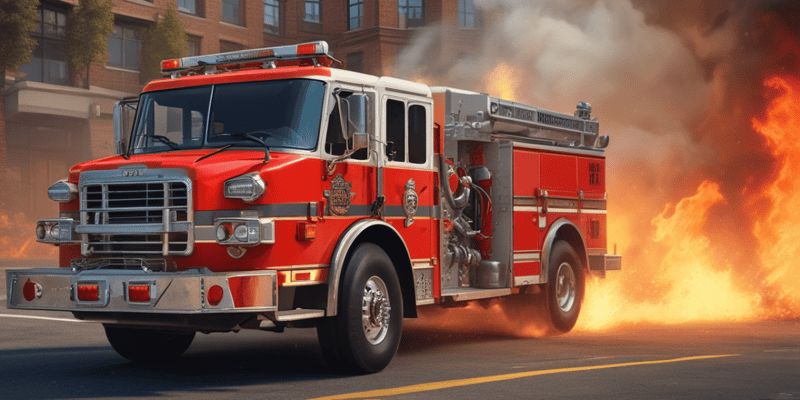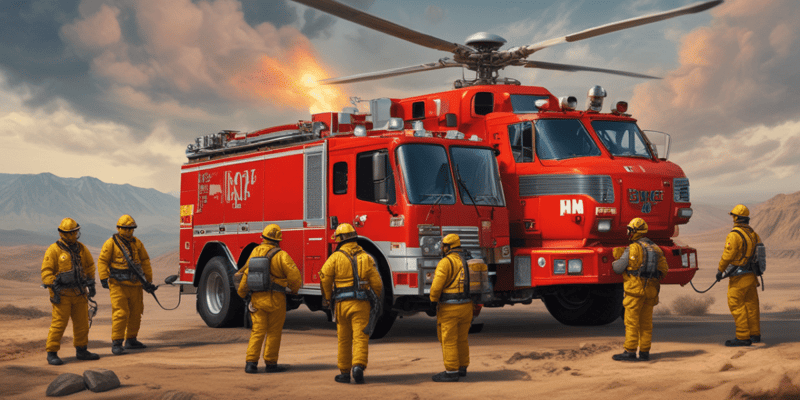Podcast
Questions and Answers
What is the primary purpose of establishing a safety zone during a structural collapse incident?
What is the primary purpose of establishing a safety zone during a structural collapse incident?
Which factor is NOT mentioned as a cause of structural collapse?
Which factor is NOT mentioned as a cause of structural collapse?
What is the first action to take upon arrival at a structural collapse scene according to the procedures outlined?
What is the first action to take upon arrival at a structural collapse scene according to the procedures outlined?
What should be done to evaluate the risk of fire travel during the scene assessment?
What should be done to evaluate the risk of fire travel during the scene assessment?
Signup and view all the answers
How can the risk of secondary collapse be assessed during the scene preparation?
How can the risk of secondary collapse be assessed during the scene preparation?
Signup and view all the answers
What is essential to obtain for operational awareness at a structural collapse site?
What is essential to obtain for operational awareness at a structural collapse site?
Signup and view all the answers
Which factor during the reconnaissance phase is critical for preventing further hazards?
Which factor during the reconnaissance phase is critical for preventing further hazards?
Signup and view all the answers
What type of hazards should be noted during the assessment according to the outlined procedures?
What type of hazards should be noted during the assessment according to the outlined procedures?
Signup and view all the answers
Which team member role is essential to ensure safety during a rescue operation?
Which team member role is essential to ensure safety during a rescue operation?
Signup and view all the answers
What should be established first to ensure safe access to the incident site?
What should be established first to ensure safe access to the incident site?
Signup and view all the answers
Which item is NOT required for each entry team during a structural collapse rescue?
Which item is NOT required for each entry team during a structural collapse rescue?
Signup and view all the answers
How should markings be made to indicate the location of each victim?
How should markings be made to indicate the location of each victim?
Signup and view all the answers
What is the maximum number of personnel that should enter a void space on each team?
What is the maximum number of personnel that should enter a void space on each team?
Signup and view all the answers
What is a critical factor in determining if a situation is a rescue or recovery operation?
What is a critical factor in determining if a situation is a rescue or recovery operation?
Signup and view all the answers
Which method is utilized for keeping track of personnel in emergency incidents?
Which method is utilized for keeping track of personnel in emergency incidents?
Signup and view all the answers
What should be done if the structural engineer believes the environment is unsafe during operations?
What should be done if the structural engineer believes the environment is unsafe during operations?
Signup and view all the answers
What is the primary purpose of the 'Hailing System' during search operations?
What is the primary purpose of the 'Hailing System' during search operations?
Signup and view all the answers
Which type of victims are categorized as surface victims?
Which type of victims are categorized as surface victims?
Signup and view all the answers
Which piece of equipment is essential for atmospheric monitoring during entry?
Which piece of equipment is essential for atmospheric monitoring during entry?
Signup and view all the answers
What should be done to ensure effective ventilation during a rescue operation?
What should be done to ensure effective ventilation during a rescue operation?
Signup and view all the answers
Which factor is NOT part of the criteria for selecting which victims to rescue first?
Which factor is NOT part of the criteria for selecting which victims to rescue first?
Signup and view all the answers
When should rescue teams mark entry points with spray paint or chalk?
When should rescue teams mark entry points with spray paint or chalk?
Signup and view all the answers
What is the primary reason for creating an inspection hole before breaching?
What is the primary reason for creating an inspection hole before breaching?
Signup and view all the answers
When establishing secondary escape routes for rescuers, what should be considered?
When establishing secondary escape routes for rescuers, what should be considered?
Signup and view all the answers
What is the maximum length a shore can be in relation to its width?
What is the maximum length a shore can be in relation to its width?
Signup and view all the answers
During void exploration, what is crucial for maintaining accountability?
During void exploration, what is crucial for maintaining accountability?
Signup and view all the answers
What should be primarily avoided when breaching walls, roofs, or floors?
What should be primarily avoided when breaching walls, roofs, or floors?
Signup and view all the answers
What type of systems are preferable for removing patients when clear from the space?
What type of systems are preferable for removing patients when clear from the space?
Signup and view all the answers
Why is cross-beam cribbing constructed with certain limitations?
Why is cross-beam cribbing constructed with certain limitations?
Signup and view all the answers
Which factor is essential to check before installing shoring systems?
Which factor is essential to check before installing shoring systems?
Signup and view all the answers
What is the purpose of performing lock out/tag out procedures?
What is the purpose of performing lock out/tag out procedures?
Signup and view all the answers
What should be the primary focus when removing general debris?
What should be the primary focus when removing general debris?
Signup and view all the answers
What should rescuers be aware of to reduce negative psychological effects?
What should rescuers be aware of to reduce negative psychological effects?
Signup and view all the answers
What is the primary focus of issuing portable radios to teams?
What is the primary focus of issuing portable radios to teams?
Signup and view all the answers
What general guideline should be followed for patient packaging?
What general guideline should be followed for patient packaging?
Signup and view all the answers
What should be done if cutting timbers that support debris?
What should be done if cutting timbers that support debris?
Signup and view all the answers
Study Notes
Structural Collapse Operations Overview
- Structural collapse incidents can result from engineering errors, fires/explosions, human factors, or natural occurrences.
- A flexible plan is essential for stabilizing incidents and rescuing victims.
- Operations require trained personnel, specialized tools, and techniques to minimize risks.
Scene Preparation and Reconnaissance
- Technical Rescue Unit Officer-in-Charge (OIC) gathers information from first responders and structural engineers upon arrival.
- Conduct a 360-degree safety survey; establish a safety zone twice the building's height.
- Identify building occupancy, number of occupants, and victim locations.
- Obtain site blueprints or sketches and evaluate structural damage and potential hazards.
Response and Entry Safety
- Appropriate response teams are dispatched as per established policies.
- A Technical Rescue Team (TRT) member must assume Incident Safety Officer (ISO) duties.
- Establish treatment, triage, and rehabilitation areas to support injured individuals.
- Ensure safe perimeter establishment and monitor atmospheric conditions before and during entry.
Equipment and Team Preparation
- All personnel entering must be equipped with radios, protective gear, and atmospheric monitors.
- Teams should include a paramedic and a backup for safety.
- The Passport Accountability System tracks personnel presence and movements within the collapse zone.
Search and Rescue Operations
- Mark victim locations with spray paint to prevent duplicated search efforts.
- Search surface victims (50% found there); explore areas for the most accessible and distressed individuals first.
- Maintain communication with rescuers, utilizing sound and tapping to locate buried victims.
Breaching and Shoring Techniques
- Create inspection holes to avoid collapse risks before breaching walls or roofs.
- Use emergency shoring to stabilize structures; consider load-bearing capacity when selecting materials.
- Wood cribbing should support cross beams and include multiple layers for stability.
Patient Removal Protocols
- Establish C-spine control and use stokes baskets for safe patient transfer.
- Mechanical systems preferred for transporting patients, minimizing manual labor where possible.
- Ensure decontamination of all entry personnel post-rescue.
General Debris Removal
- Use heavy machinery for debris clearance after all survivors are recovered.
- Prioritize search areas systematically during debris removal.
Safety Considerations
- Mandate protective gear, ventilate areas, and implement utility lockout/tagout procedures.
- Conduct regular safety analyses every 30 minutes to monitor collapse risks.
- Ensure psychological support is available for rescuers, factoring in psychological stress during operations.
Termination of Operations
- Conduct a roll call to ensure all personnel are accounted for.
- Seal off access points post-operation to prevent unauthorized entry.
- Complete necessary reports, including NFIRS and OSHA documents, following operational conclusion.
Studying That Suits You
Use AI to generate personalized quizzes and flashcards to suit your learning preferences.
Description
This quiz covers the critical aspects of structural collapse operations, focusing on incident stabilization and rescue methods. It highlights the need for trained personnel and specialized techniques to effectively manage various collapse scenarios. Test your knowledge on implementing flexible plans for effective mitigation in challenging situations.




